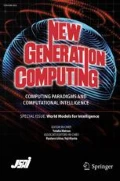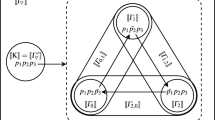Abstract
We present a system for performing belief revision in a multi-agent environment. The system is called GBR (Genetic Belief Revisor) and it is based on a genetic algorithm. In this setting, different individuals are exposed to different experiences. This may happen because the world surrounding an agent changes over time or because we allow agents exploring different parts of the world. The algorithm permits the exchange of chromosomes from different agents and combines two different evolution strategies, one based on Darwin’s and the other on Lamarck’s evolutionary theory. The algorithm therefore includes also a Lamarckian operator that changes the memes of an agent in order to improve their fitness. The operator is implemented by means of a belief revision procedure that, by tracing logical derivations, identifies the memes leading to contradiction. Moreover, the algorithm comprises a special crossover mechanism for memes in which a meme can be acquired from another agent only if the other agent has “accessed” the meme, i.e. if an application of the Lamarckian operator has read or modified the meme.
Experiments have been performed on the η-queen problem and on a problem of digital circuit diagnosis. In the case of the η-queen problem, the addition of the Lamarckian operator in the single agent case improves the fitness of the best solution. In both cases the experiments show that the distribution of constraints, even if it may lead to a reduction of the fitness of the best solution, does not produce a significant reduction.
Similar content being viewed by others
References
Ackely, D. H. and Littman, M. L., “A Case for Lamarckian Evolution,”Artificial Life III. (Langton, C. G. ed.), Addison Wesley, 1994.
Alferes, J. J., Damásio, C. V. and Pereira, L. M., “SLX — A Top-down Derivation Procedure for Programs with Explicit Negation,” inProc. of Int. Symp. on Logic Programming (Bruynooghe, M. ed.), The MIT Press, 1994.
Alferes, J. J., Damásio, C. V. and Pereira, L. M., “A Logic Programming System for Non-monotonic Reasoning,”Journal of Automated Reasoning, 14, pp. 93–147, 1995.
Alferes, J. J. and Pereira, L. M.,Reasoning with Logic Programming, 1111, ofLNAI, Springer-Verlag, 1996.
Alferes, J. J., Pereira, L. M. and Przymusinski, T. C., ““Classical” negation in non-monotonic reasoning and logic programming,”Journal of Automated Reasoning, 20, pp. 107–142, 1998.
Alferes, J. J., Pereira, L. M. and Swift, T., “Well-founded Abduction via Tabled Dual Programs,” inProc. of the 16th International Conference on Logic Programming (de Schreye, D. ed.), pp. 426–440, MIT Press, 1999.
Baldwin, J. M., “A New Factor in Evolution,”American Naturalist, 30, pp. 441–451, 1896.
Blackmore, S.,The Meme Machine, Oxford U.P., 1999.
Brglez, F., Pownall, P. and Hum, R., “Accelerated ATPG and Fault Grading via Testability Analysis” inProc. of IEEE Int. Symposium on Circuits and Systems, pp. 695–698, 1985. The ISCAS85 benchmark netlist are available via ftp monc.monc.org.
Damásio, C. V. and Pereira, L. M., “Abduction on 3-valued extended logic programs,” inLogic Programming and Non-Monotonic Reasoning — Proc. of 3rd International Conference LPNMR’95, 925 of LNAI (Marek, V. W., Nerode, A. and Trusczynski, M. ed.), pp. 29–42, Springer-Verlag, 1997.
Damásio, C. V. and Pereira, L. M., “A Survey on Paraconsistent Semantics for Extended Logic Programs,”Handbook of Defeasible Reasoning and Uncertainty Management Systems (Gabbay, D. M. and Smets, Ph. eds.),2, pp. 241–320. Kluwer Academic Publishers, 1998.
Damásio, C. V., Pereira, L. M. and Schroeder, M., “REVISE: Logic Programming and Diagnosis” inProc. of Logic-Programming and Non-Monotonic Reasoning, LPNMR’97, 1265 of LNAI, Springer-Verlag, 1997.
Dawkins, R.,The Selfish Gene, Oxford University Press, 1989.
Dietterich, T., “Approximate Satistical Tests for Comparing Supervised Classification Learning Algorithms,”Neural Computation, in press (draft version available at http://www.cs.orst.edu/tgd/projects/supervised.html), 2000.
Dix, J., Pereira, L. M. and Przymusinski, T., “Prolegomena to Logic Programming and Non-monotonic Reasoning,” inNon-Monotonic Extensions of Logic Programming — Selected Papers from NMELP’96 (Dix, J., Pereira, L. M. and Przymusinski, T. eds.),1216, in LNAI, pp. 1–36, Springer-Verlag, 1997.
Gelfond, M. and Lifschitz, V., “The Stable Model Semantics for Logic Programming,” inProc. of the 5th Int. Conf. on Logic Programming (Kowalski, R. and Bowen, K. A. eds.), pp. 1070–1080, MIT Press, 1988.
Grefenstette, J. J., “Lamarckian Learning in Multi-agent Environment,” inProc. of 4th Intl. Conference on Genetic Algorithms, Morgan Kauffman, 1991.
Hart, W. E. and Belew, R. K., “Optimization with Genetic Algorithms Hybrids That Use Local Search,” inAdaptive Individuals in Evolving Populations (Belew, R. K. and Mitchell, M. eds.), Addison Wesley, 1996.
Li, Y., Tan, K. C. and Gong, M., “Model Reduction in Control Systems by Means of Global Structure Evolution and Local Parameter Learning,” inEvolutionary Algorithms in Engineering Applications (Dasgupta, D. and Michalewicz, Z. eds.), Springer-Verlag, 1996.
Malheiro, B., Jennings, N. R. and Oliveira, E., “Belief Revision in Multiagent Systems,” inProc. of the 11th European Conference on Artificial Intelligence, 1994.
Mitchell, T. M.,Machine Learning, McGraw Hill, 1997.
Pereira, L. M. and Alferes, J. J., “Well Founded Semantics for Logic Programs with Explicit Negation,” inProc. of the European Conference on Artificial Intelligence ECAI92, pp. 102–106, John Wiley and Sons, 1992.
Pereira, L. M., Damásio, C. V. and Alferes, J. J., “Diagnosis and Debugging as Contradiction Removal,” inProc. of the 2nd International Workshop on Logic Programming and Non-monotonic Reasoning (Pereira, L. M. and Nerode, A. eds.), pp. 316–330, MIT Press, 1993.
Spector, L. and Luke, S., “Cultural Transmission of Information in Genetic Programming,”Genetic Programming 1996: InProc. of the First Annual Conference, pp. 209–214, The MIT Press, 1996.
Spector, L. and Luke, S., “Culture Enhances the Evolvability of Cognition,” inProc. of the 1996 Cognitive Science Society Meeting, 1996.
van Gelder, A., Ross, K. A. and Schlipf, J. S., “The Well-founded Semantics for General Logic Programs,”Journal of the ACM, 38, 3, pp. 620–650, 1991.
Author information
Authors and Affiliations
Additional information
Evelina Lamma, Ph.D.: She is Full Professor at the University of Ferrara. She got her degree in Electrical Engineering at the University of Bologna in 1985, and her Ph.D. in Computer Science in 1990. Her research activity centers on extensions of logic programming languages and artificial intelligence. She was coorganizers of the 3rd International Workshop on Extensions of Logic Programming ELP92, held in Bologna in February 1992, and of the 6th Italian Congress on Artificial Intelligence, held in Bologna in September 1999. Currently, she teaches Artificial Intelligence and Fondations of Computer Science.
Fabrizio Riguzzi, Ph.D.: He is Assistant Professor at the Department of Engineering of the University of Ferrara, Italy. He received his Laurea from the University of Bologna in 1995 and his Ph.D. from the University of Bologna in 1999. He joined the Department of Engineering of the University of Ferrara in 1999. He has been a visiting researcher at the University of Cyprus and at the New University of Lisbon. His research interests include: data mining (and in particular methods for learning from multirelational data), machine learning, belief revision, genetic algorithms and software engineering.
Luís Moniz Pereira, Ph.D.: He is Full Professor of Computer Science at Departamento de Informática, Universidade Nova de Lisboa, Portugal. He received his Ph.D. in Artificial Intelligence from Brunel University in 1974. He is the director of the Artificial Intelligence Centre (CENTRIA) at Universidade Nova de Lisboa. He has been elected Fellow of the European Coordinating Committee for Artificial Intelligence in 2001. He has been a visiting Professor at the U. California at Riverside, USA, the State U. NY at Stony Brook, USA and the U. Bologna, Italy. His research interests include: knowledge representation, reasoning, learning, rational agents and logic programming.
About this article
Cite this article
Lamma, E., Riguzzi, F. & Pereira, L.M. Belief revision via Lamarckian evolution. New Gener Comput 21, 247–275 (2003). https://doi.org/10.1007/BF03037475
Received:
Revised:
Issue Date:
DOI: https://doi.org/10.1007/BF03037475




